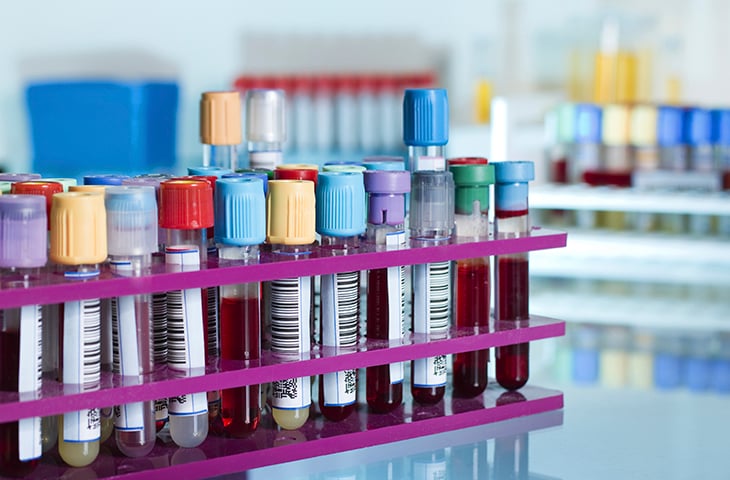By David Wold
Today’s hematology labs are faced with escalating demands to deliver robust and accurate blood test results quickly. At the heart of automated diagnostic systems for blood analysis are liquid handling pumps, which must deliver precise and accurate results every time. As well as being reliable, they must also be affordable and easy to maintain. Unfortunately, not all pumps deliver to these exacting standards. What are the most important factors for an engineer to consider when selecting a pump to meet the stringent performance required for a hematology automation system?

Selecting the right combination of liquid handling pump features can help to ensure your instrument delivers the precision, accuracy, consistency, and speed required for patient-critical automated blood testing.
Pump precision and accuracy are paramount
Worldwide population growth and greater access to medical care are putting increased pressure on hematology labs. Blood testing is most often the first step in diagnosing, monitoring, and treating diseases. Precision and accuracy in both liquid handling and sample handling should therefore be primary considerations for the engineer when designing hematology analyzers and other analytical systems in the hematology workflow. A pump that is not held to the highest standards can seriously compromise test processing time and results. The effects of inaccurate or imprecise pipetting can strike anytime during the testing process.
Imagine this scenario. Your loved one undergoes an organ and stem cell transplant. She requires careful monitoring and frequent testing to determine the precise doses of immunosuppressants to support recovery and minimize rejection. In tailoring her treatment, precision pipipetting of blood sample volumes, buffers, and reagents for the established hematology workflow will dictate her drug dosages and treatment protocols. In this situation, precise and accurate results can be a matter of life or death.
Common factors that can compromise accuracy and precision
The pump drive mechanism has a significant effect on accuracy and precision. A drive mechanism that delivers high-resolution microstepping and low pump-to-pump component variability quality enables precise high-resolution liquid handling, especially for very small pipetting volumes. This is critical when working with limited samples at higher dilutions, or when diagnosis requires very sensitive detection.
When using a syringe pump, the valve, seal, and design of the syringe will impact quality and accuracy. Whether low- or high-volume, a healthy syringe will aspirate and dispense fluid consistently from test to test and lab to lab. A syringe in which the plunger is not seated properly and has non-linear motion could cause inconsistent aspirating and dispensing. Seals between moving parts such as between the plunger and the barrel are also critical to minimize leakage and cross-contamination.
In addition, any degree of cross-contamination can compromise the accuracy of test results, and is therefore unacceptable when patients are involved. In the transplant scenario described above, a high-performance liquid handling workflow that ensures zero cross-contamination could mean the difference between a quick, accurate, and certain donor match versus delays due to repeated testing. Zero cross-contamination starts with a high-performance liquid handling pump, as well as careful tip selection and proper tip washing.
Reliable design and control of complex liquid handling pumps can not only help reduce the risk of cross-contamination in handling samples but also enhance the precision in overall pipetting results. Check the pump fluid path and liquid tube routing. Minimal liquid tube routing creates more efficient fluidic paths so there is less dead-volume and fewer points where liquid handling variations can occur. Are there places that may trap sample and result in cross-contamination?
Sealed sample containers are sometimes required for handling blood products and often under negative pressure vacuum. A system that offers hands-free cap piercing instead of manual cap removal will minimize manual labor, risk of cross-contamination, and the impact of negative pressure on the liquid handling performance.
Designing for reliability and consistent pump performance
Blood staining and smearing onto hemocytometers require very accurate and precise dispensing. In a flow cytometer, slower flow rates will support more reliable blood cell separation for accurate cell counting and morphology characterization, while maintaining the integrity of the cells in the sample. Blood chemistry analyzers also require slow and consistent flow rates, but are not constrained by the need to maintain cell integrity. Unique formats such as arrays or cartridges for specialized test platforms might require a different combination of features and performance specifications.
Trouble-free performance should not be taken for granted, especially in clinical applications. Incorporating process security features such as tip sensors, liquid level detection (LLD), and cycle counters into your instrument can help your customers to identify run problems quickly and plan for routine maintenance to minimize delays in patient-critical testing. Careful matching of fluid types to pump materials ensures your liquid handling instrument will stand up to frequent or aggressive wash procedures that may be required to eliminate cross-contamination and operator exposure from blood samples. Read our previous blog “How to secure long-term performance of OEM components for automated liquid handling” to learn more about this topic.
Speed is of the essence for hematology applications
Efficiency risks being compromised during multi-step assays, as time penalties from each step accumulate throughout the workflow. It is crucial to maximize precison and accuracy at every step when processing a large volume range in a system that performs an entire blood handling and analysis workflow. A wide choice of pump configurations and pump types, along with universal communication tools, give you the ability to control complex fluidics pathways and incorporate a range of liquid handling capabilities on the same platform. All of these factors are important considerations for rapid and high-throughput turnaround of patient results.
Back to the example of the post-operative transplant patient. Depending on the test, it may be several hours before results are available. This means that any medication dosages prescribed will be based on the level of immunosuppressants that were present at the time the blood sample was drawn, yet those levels may have changed over the time it took to deliver test results. Multiple fluid path channels and parallel sample processing can sometimes be used to minimize testing time. In choosing a liquid handling pump for automated blood testing applications, consideration of the number and types of samples and reagents, as well as the volumes, viscosities, and speeds required at different steps in blood analysis process can help to increase the assay speed and ultimately reduce the time to get accurate test results and treatment.
These factors are addressed by pump features and options:
- Fluid path distribution from multiple channels, valves, and ports
- Breadth of volume sizes
- Volume range from high-resolution low-volume sample handling to bulk fluid dispensing
- Range of tip types (cap-piercing, fixed, disposable, wide-bore, or low-volume)
Commitment to quality
Millions of diagnostic tests are performed every day, all around the world. People’s lives depend on them. Hematology labs rely on highly accurate and precise instruments to yield consistent results in a timely fashion. Blood components, types of analyses, and technologies used in different hematology applications all put different demands on automated blood handling and analysis systems. By considering the tip formats, pipetting volumes, and speeds that your liquid handling pump must provide, you can help to ensure your automated blood sample handling instrument will yield accurate, precise, and reliable cell counts and test results.
Are you faced with the daunting challenge of finding the right combination of pump features that can deal with the wide range of sample types, tests, and technologies that will be used on your platform? Read how NGNY Devices have overcome similar practical challenges using Tecan components to automate laborious pre-analytical sample processing for clinical testing.
Contact us to help you choose the best pump for your automated hematology liquid handling instrument.
About the author

David Wold
David Wold is the Customer Operations Manager for the Partnering Business in the Components Marketing Team. In this role, he oversees a team responsible for the support and satisfaction of Tecan’s top Components customers. Since 2005, David has helped Tecan customers meet their liquid handling challenges across a broad range of technologies and applications. He brings understanding and expertise to help customer choose components to meet their needs, provide maximum reliability and outstanding performance.












